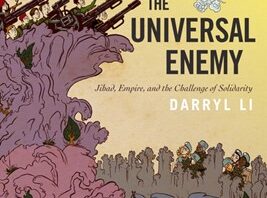Since its publication in 2019, Darryl Li’s The Universal Enemy: Jihad, Empire, and the Challenge of Solidarity (Stanford University Press) has been the focus of a great deal of attention and debate. This historical ethnography of jihad fighters in 1990s Bosnia touches on some of the central questions of our era, using the plural concept of “universalisms” to bring many of the historical forces in this conflict into conversation with one another. Drawing on the author’s legal background and work as well as his anthropological training, the dense narrative connects Bosnia to the far-flung homes of the mujahideen, from North Africa to Southeast Asia, and to the carceral archipelago constructed by the US in its war on terror. Delving into the little-explored, everyday universalisms of Third World students and UN peacekeepers as well as jihad participants, Li demonstrates a wealth of empathy which can be as unsettling for radical readers as it is for liberals. Matan Kaminer of LeftEast and Dr. Li held the following exchange about the book and its lessons last month. An abridged version has been published by Allegra Lab.
On personal universalisms
MK: Thank you so much for agreeing to this conversation, Darryl. The Universal Enemy was fantastic to think with, and has brought up a wide variety of questions for me. I’m an activist on the Israeli left and a PhD graduate in anthropology from the University of Michigan. I wrote a dissertation on Thai migrant workers in Israeli agriculture, and I’m now starting a postdoctoral project about how the Thai military’s interest in Israeli “frontier settlement” catalyzed the flow of migrant labor between the two countries. I’m also a member of the LeftEast collective, the bulk of whose members are Eastern European, mostly Southeast European, with a strong representation for ex-Yugoslavs. The Israeli left is extremely parochial, and discovering a network of comrades in a region that is both so geographically close and so historically connected to my country was a kind of homecoming experience, one reflected in a piece I wrote trying to think Israel as an Eastern European country.
This background is pertinent to the way I’m interpellating you both as a fellow foreigner in the Balkans (though a much more knowledgeable one), and as a participant in the particular kind of universalism known as the Left. Hence, I’d like to begin with your background. How did your personal history of activism and research bring you to this project, and what effect did that history have?
DL: During the early 1990s, the crises in the former Yugoslavia attracted enormous visibility and the region therefore became a space of fantasy projection for people coming from different parts of the world. The book shows how transnational jihad activism was a part of this common global story, in which you and I also take part of course.
With the Cold War having recently ended, the US was trying to make sense of and justify its unprecedented global hegemony. At the same time, the 50th anniversary commemorations of the end of World War II and the Holocaust provided a backdrop for making sense of mass atrocities occurring in the world. This moment is crystallized by the opening of the US Holocaust Museum in 1993 (which by the way is also the year Schindler’s List was released). At this event, Elie Wiesel turns to President Clinton and implores him to do something about the atrocities in the former Yugoslavia. It’s Bosnia in particular that strikes a chord with all these Americans who are simultaneously immersed in Holocaust commemoration – Bosnia much more than sites of mass violence in Africa, which of course has a lot to do with race.
Coming from a middle-class Asian-American immigrant family, I was assimilating into a normatively white American public culture at this time. The wars in ex-Yugoslavia were among my earliest memories of world events and I was shaped by that prevailing feeling of optimism, leavened by uncertainty, in American elite discourse. My own assimilation experience was also a search for something more universal, as expressed by this sense of an international-community space. To the extent Asian-Americans had become part of the foreign policy world of the United States, it was often in the mold of the anti-communist émigré, something that held little appeal for me ideologically (despite my family’s own historical affiliation with the Kuomintang).
Instead, I had ideas of working for the UN or for human rights organizations, but because of my own differently racialized immigrant position, my identification with this project was shaky and contingent. I could never identify with white saviors but also never dreamed of speaking for the oppressed – Cathy Park Hong has written evocatively about middle-class Asian-American subjectivities in a liminal space in U.S. racial hierarchies and how this can give rise to intense self-abnegation, of feeling like a “urinal cake of shame.” In any event, my commitment to liberal humanitarianism basically fell apart around the early 2000s, with the Second Intifada and the events of 9/11. That’s where I kind of got off that train.
MK: You were in college?
DL: Yes, it was my final year of college, the Second Intifada broke out, and I discovered new things about liberalism. When I graduated, I went to Palestine to work for a local NGO and on 9/11 I was living in the Gaza Strip, so I was already exploring alternatives to mainline liberal humanitarianism.
As a person of Chinese origin, I’ve always understood my role in these projects to be necessarily peripheral, but I’ve tried to make my best out of the particular advantages that position has afforded. For my interlocutors, both in Palestine and in Bosnia when I did my fieldwork there some years later, China was primarily an object of curiosity, seen as important and powerful enough to be respected, but not encountered directly enough to be resented. In most of these situations, I was the first Chinese person they were encountering in the role that I was playing, and that always creates a moment of slight confusion, hesitation and surprise. Now, because of what’s been happening in Xinjiang/East Turkestan, those attitudes might have changed. On a daily level, of course, I experienced public space in Bosnia as a gantlet of racial harassment, taunts, and so on.
But even that is not disconnected from political economy, because that was a moment of expansion of commercial ties with China in the region. Mostly with Serbia, but every medium-sized or large town in Bosnia now also has a Chinese retail outlet that provides cheaply produced commercial goods, and as with “middleman minorities” anywhere, that produces resentment and backlash.
MK: The layperson’s view of the Cold War is very bipolar: the US vs. the USSR. But in fact China has played an independent role on the world stage since the 1950s, and remembering that may be useful to rethinking its role in the Balkans.
DL: There’s also a temporal rethinking that’s needed here. Recently Adam Tooze published an article which argues that it’s premature to talk about the Cold War as having ended. The so-called democratic revolutions of 1989 started with Tiananmen, which led to a massive consolidation of state authority rather than the collapse of state socialism. So instead of talking about the “post-Cold War” era, we might talk of a shift from a U.S.-Soviet bipolarity to a U.S.-China bipolarity of intertwined neoliberal projects.
In the chapter on the Non-Aligned Movement (NAM) in the book, I tried to bring in a broader set of research interests, to get anthropologists and social historians in there, because what I had read was so focused on summitry and meetings between great men. While that’s very important, there’s something frustrating and limiting about it. A slightly broader scholarly outlook studies public discourse and cultural production, but still often looks at texts in this sort of vacuum. Trying to figure out the connective tissue of these things is really a different endeavor.
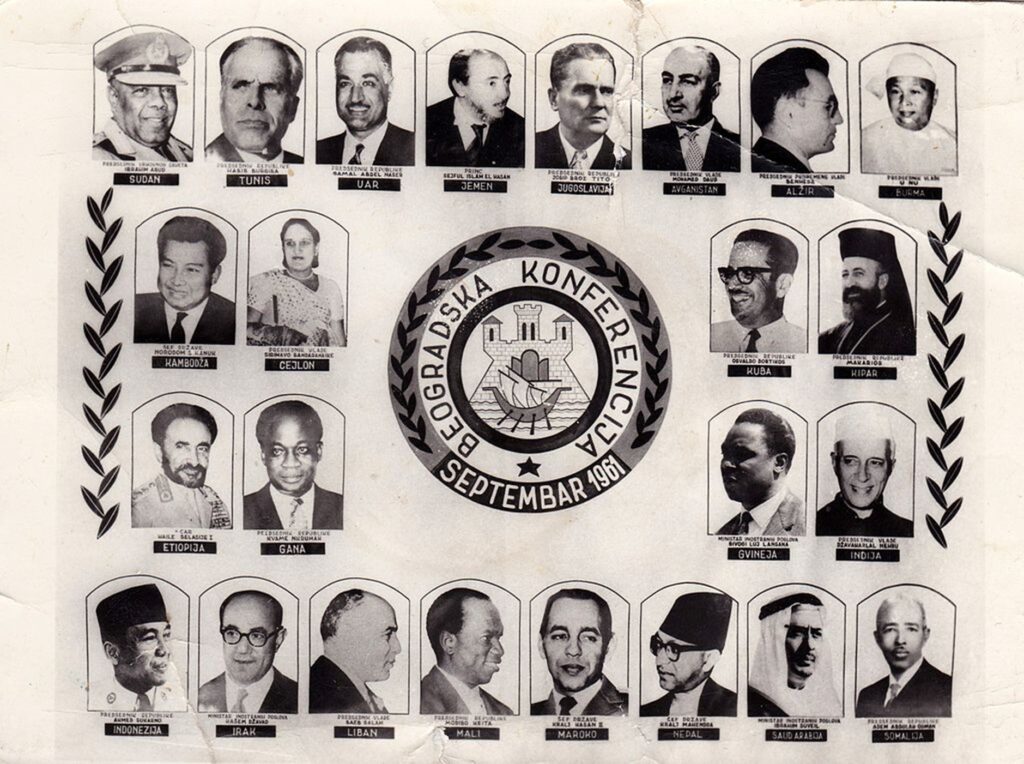
MK: I think that’s one of the book’s strong points. Conversely, you might say that anthropologists have also been remiss in our duties because we’ve become kind of myopic. In the 1990s, even very mainstream anthropologists were talking about ethnographies of the world-system. Some people are still doing that, but it’s not very prevalent among my generation.
DL: Well it is difficult, so we could cut people a bit of a break. But I agree that the discipline tends to reward those who have micro data and very macro claims. Meso-level reconstruction – which is often where one can say more interesting and concrete things about politics – is not as much in evidence, and I think we need a lot more of that. It’s funny because so-called transnational, multi-sited anthropology has been fashionable for a while, but there’s still often something lacking in the connection to political questions. Usually there’s a very generic claim about something like governmentality or neoliberalism, and then a leap to the micro, and back. Which is fine, but different from what we’re talking about here.
On Internationalism
MK: My next question is about the kind of universalism known as internationalism. In the contexts of the NAM and peacekeeping, you characterize internationalism as a logic which “treats the state as the basic unit” for the deployment of universal sentiments and practices (p. 172), but this leaves out left-wing understandings of the term, which date back at least to the Communist Manifesto. Internationalism was the cry of the volunteers of the Spanish Civil War, but it was also the ideology of the Yugoslav partisans of World War II. The unique success of the Yugoslav partisans in defeating the Nazis enabled Tito to achieve autonomy from both Cold War blocs, which in turn made it possible for Yugoslavia to play an important role in the NAM. And that success was predicated on the partisans’ ability to foster internationalism within their ranks, against the nationalist currents of the period.
Echoes of this can be heard in a rather astonishing episode you relate (p. 162). Two Syrian mujahideen who had studied in Serbia and Croatia before the war jocularly call each other “Četnik” and “Ustaša,” derogatory terms for the nationalist movements of these two national groups respectively. From a left point of view, then, it appears important to take up those cadences of internationalism that predate its domestication by the post-war state system. Can you help fill in this space by talking a bit about the legacy of the partisans in Bosnia? Has that legacy been present in Bosnian politics?
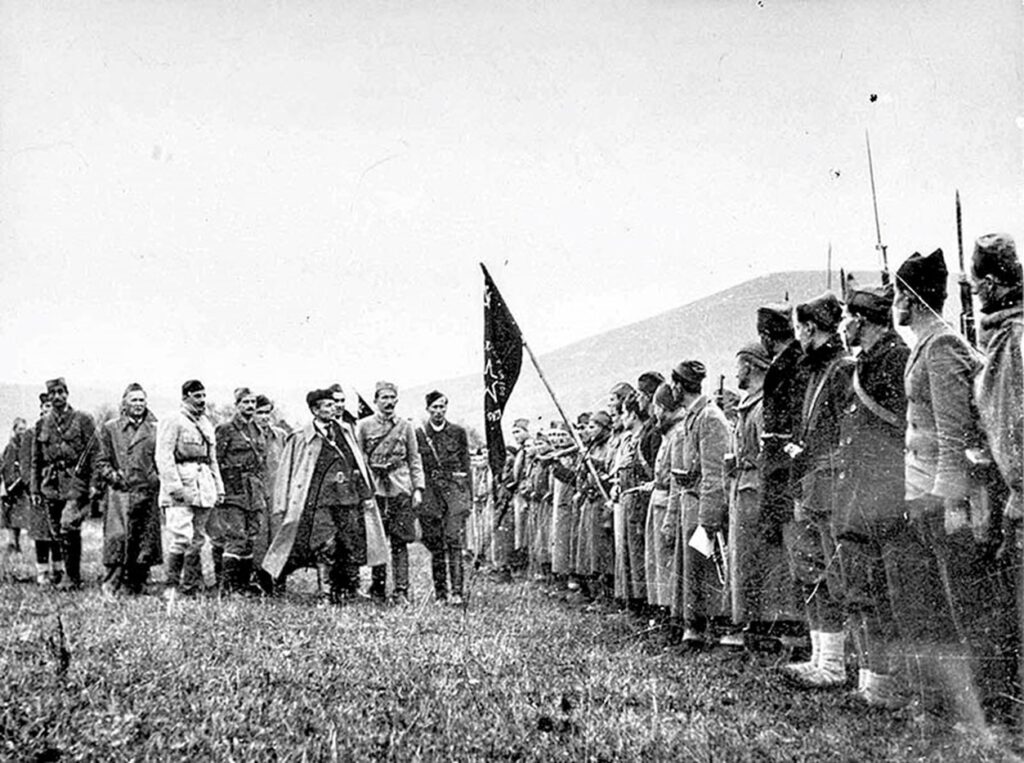
DL: That’s a great question. You’re absolutely correct that my heuristic use of internationalism in the book does not engage with the actual histories of capital-I Internationalism, and that’s an oversight. In the modern period, it’s very difficult to escape the organizing logic of nationalism, in pan-Islamic movements as well as on the left. As you pointed out, transnational left activities are often organized along national lines. The International Brigades in Spain were organized on a national basis, and named for national figures like Abraham Lincoln.
Yugoslavia is a major example of how the left has been challenged by the category of nationalism. This was a multi-national federation that also tried to create a new kind of nationalism. Although Tito was successful in forging his project at a particular moment, there was always constitutional recognition of the disparate national projects within the federation – Serb and Croat ones in particular. Your question reminds me of one of the characters in the book, Mehmud, a Bosnian mujahid who shows up in Chapter 2. He’s a strong supporter of the SDA, which is the major Bosniak nationalist political party, but his uncle was a partisan. They have lots of arguments, but he loves his uncle quite dearly. So even within one family there are competing ideas about how commitments to nationalism branch out and reach toward other potential points of connection and allegiance outside the country.
Now, a few generations passed between the end of World War II and this war, but the ethos of the partisan war is part of the discourse, for example in the territorial defense militias. One reason things happened the way they did in Bosnia was that most of the personnel and resources of the Yugoslav national army were coopted into the Serb nationalist project, leaving Bosnians unarmed and unprepared. When Bosnia was trying to cobble together a national army, one of their sources were these militias that ran parallel to the Yugoslav national army and invoked the partisan tradition of local self-defense. Many of those guys ended up organizing the new Bosnian army, and when the first Arab mujahideen arrived, they hooked up with them, even though they didn’t have much in common, in terms of a religious practice orientation or otherwise.
One of the book’s protagonists, Abu ‘Abd al-‘Aziz, gave an interesting interview in which he said: look, we’re here fighting alongside this territorial defense formation, and we’re also fighting alongside the Croatian nationalist militia, the HOS, which has continuities with the fascist Ustaša. But there’s a peculiar feature of Croatian nationalism whereby the more fascistic strands have been in some ways more philo-Islamic, seeing Bosnian Muslims as Croats of the Muslim faith.
This connects to histories from World War II, like the Handschar Division of the SS, but Abu ‘Abd al-‘Aziz’s point is that the territorial defense militia and the HOS are on the same playing field. The TO is predominantly Muslim but has no particular orientation towards religious practice or even towards religious nationalism. From his point of view, none of these people are praying, they’re all drinking, but we’re also just here fighting this war, and this is how it is.
But structurally it’s also a different kind of war. It’s not a guerrilla war; that makes it different from the partisan project, and also from a lot of other jihad projects. This is a war about the establishment and consolidation of a nation-state territory. You have trenches, front lines, infantry charges. In that sense, it’s quite conventional. Even there, I’m sure the partisan experience is invoked at some level, but I don’t know how you would see any kind of embodied practice of that coming out, for example. Political education maybe, the fact that they had religious education going on parallel with the fighting, but I can’t say that that was done with the partisan example in mind.
MK: That clarifies a few things for me, as I did have more of a guerilla scenario in mind. This brings up more geographical questions, since Bosnia is a pretty mountainous place, much like Afghanistan, and partisan warfare is in part about taking advantage of locals’ knowledge of that terrain. That, I think, was very important to partisan strategy in World War II. Do you see any sort of connections between questions of military strategy and the ideological questions that are more salient in the book?
DL: Bosnia’s terrain is less mountainous than Afghanistan’s, but you’re right that there are high elevations – this had the effect of making the war quite static. The front lines were mostly established in the early months, when the Serb and Croat forces grabbed territory and ethnically cleansed a lot of people, and they didn’t change terribly much until the last segment of the war. The Bosnian Serbs’ possession of heavy artillery and command of high-elevation areas enabled them to exert force in ways that compensated for their smaller numbers of troops. And this created a problem for the Bosnian army, which needed to take these mountaintops that had cannons on them, but it was difficult to do that, especially when you factor in weather and the lack of air support.
MK: That’s very apparent from Omar Khouri’s fabulous cover for the book. I don’t know if this was intentional, but the topography is clear there as well.
DL: The particular attack that the cover illustrates was postponed several times over the course of a year, in part because the weather was not on the side of the mujahideen. They didn’t have their own air support until the angels intervened, as their story and the cover recount. There was actually a lot of waiting around in the war. It almost makes me think of trench warfare in World War I. You have time away from the front line for conversations about politics and religion and so on.
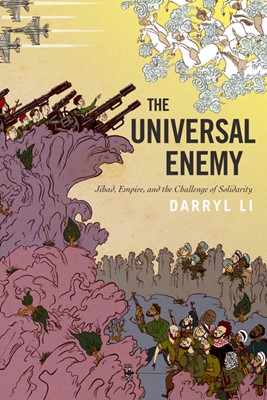
On cosmopolitanism
MK: The second universalism I wanted to discuss with you is cosmopolitanism, which I would venture to define as an attitude which values the intermingling of people of different origins and cultural interaction as an end in itself, opposing the elision of cultural difference. As we’ve discussed, mujahideen in Bosnia were very cosmopolitan in their attitudes to national differences, but the Yugo-nostalgia of many of your interlocutors who came to the Balkans in NAM contexts is also cosmopolitan: this is clear, for example, in Nadir’s evaluation of the changes in Banja Luka (pp. 164-8).
But unlike internationalism, cosmopolitanism was a fraught term under socialism, even a derogatory one at times. Whereas internationalism can be squared with ideologies of autochthony – we can all be in solidarity if everyone stays in their place, or at least goes home when the war is over – this is not the case with cosmopolitanism. “Rootlessness” is always implicated in the idea that people might be more comfortable among those different from themselves than at “home.” Hence, as you remark, non-Slavic people can find themselves without national representation in Bosnia, on the basis of their presumed mobility or non-autochthony. Violence against Jews and Roma in the region can be seen as anti-cosmopolitan, as can the current hostility towards Chinese and other immigrants. In this sense your repeated documentation of perceptions of the mujahideen as “rootless” seems very important. Can you say more on this aspect?
DL: That’s a really helpful distinction, between internationalism as good, rooted solidarity and cosmopolitanism as bad, rootless solidarity. I’m less familiar with how this might have played out during the socialist era, but it was very much in evidence during the war. The argument of certain Croatian and Serbian nationalists about Bosniaks was not simply that they’re different, but that they’re Turks, they don’t even belong in the area, they are essentially settlers. And that is essentially connected to the “Muslim question,” not just in Yugoslavia but in Eastern Europe, as well as in South Asia.
MK: Right. Cosmopolitanism is also associated with nostalgia for the multi-ethnic empires of the pre-World War I period, and especially the Ottoman Empire. How are attitudes in Bosnia inflected by the Ottoman past?
DL: In multi-confessional imperial polities like the Mughal or the Ottoman Empires, Muslimness by itself wasn’t an obvious basis for creating a strong national or even communal identity. While the ruling dynasts are themselves Muslim, that doesn’t decide their relation to subjects who are Muslim but also cross-cut by various other factors like region, language, class, and so on. Belonging to empires gave people – including non-Muslims – a broad range of potential identities and connections, such that it wasn’t clear to them that re-organizing along national lines necessarily made sense.
With the rise of nationalism, the status of these groups suddenly becomes more questionable. For Bosniaks, Muslimness is what allegedly sets them apart from Serbs and Croats; but even that is an open question. What was in an earlier moment their arguably greater enjoyment of cosmopolitan privileges now becomes reason for regarding them as “backward” in developing national consciousness. Rather than backwardness, though, it’s Muslimness that allowed them access to a broader range of identities and connections, such that it wasn’t clear to them that re-organizing along national lines necessarily made sense.
Either way, it played into this idea is that Bosniaks are not really a nation (and therefore they are just Serbs and Croats in denial), and it’s only a short distance from there to saying that they’re rootless and don’t belong here. Edin Hajdparasic calls this dynamic that of the (br)other, who is precariously situated as both Brother and Other.
So there’s a kind of cosmopolitanism charge, but insofar as cosmopolitanism is correlated with elitism, it’s usually a question of numbers. The classic cosmopolitan groups are minorities, like Jews or Parsis; I’m thinking of that old Parsi story of the local potentate who says “my kingdom is like this cup of milk that’s already full, I have no room for your people.” Then the Parsis add sugar to the milk and say, “see, we’re not taking up space, we’re just making it sweeter.” That notion of cosmopolitanism is harder to square with the Bosnian Muslim presence, because they have demographic bulk. They are in that messy spot on the border between the categories of cosmopolitanism and nationalism, which may help explain why things got so fraught and violent.
MK: This also has to do with the urban/rural distinction and questions of industrialization, right? The cities in Yugoslavia are the cosmopolitan spaces. That’s why they’re more dangerous and fraught from a nationalist point of view than the countryside. Although I guess in Yugoslavia the countryside was so mixed as well that it’s hard to make that distinction.
DL: You’re right that the urban-rural divide is very strong in ex-Yugoslavia, but it doesn’t correlate strongly with national or confessional categories. Of course there is an argument that Sarajevo was targeted in particular because of its cosmopolitan character. I don’t think that’s wrong, but I wouldn’t want to lose sight of the incredible violence that was done in villages and outlying areas.
MK: Sarajevo is not actually very prominent in the book. Was that a conscious decision?
DL: No, it was simply because there weren’t many jihad fighters there, because access was so difficult. Sarajevo was symbolically extremely important, but because it was besieged, the Bosnian army headquarters was actually in Kakanj, and the largest city under its relatively uncontested control was Zenica, which was connected to Croatia and the coast. So when the Bosnian Croats and the Bosnian army weren’t fighting each other, there was access to the outside world from there. For that reason, the people I’m writing about don’t really show up in Sarajevo. But now I’m thinking that because Sarajevo is such a symbol of cosmopolitanism and the international concern for the war, it makes sense that to tell a counter-narrative to that story, you would have to be based in a place like Zenica. I hadn’t thought to make that contrast more explicit.
MK: I haven’t been to Zenica, but I have been to Tuzla. I spent a few days there with a local leftist friend, and for him it was very important to underline the history of internationalism and solidarity in the city. He took me to the cemetery and showed me the graves of Jews, Christians and Muslims, and talked about the socialist legacy of industrialization as also bringing about cosmopolitanism, a weakening of confessional boundaries. That seemed like an important aspect of the cities in Bosnia, though I don’t know if all the cities are like that.
DL: A lot of the cities, as you mentioned, are organized around industry or specific resources. Even the word tuzla harkens to the city’s importance for salt mining in Ottoman times, just as Srebrenica gets its name from its connections to silver mining. Sabrina Perić has written wonderfully about these deep material histories of mining and natural resource extraction in Bosnia. The sort of tour you described your friend giving is very common. There are so many different ways of thinking about the history of this place, and connecting to different things…
MK: Somehow you always end up in cemeteries though, right?
DL: Yeah! Well, that’s where the bodies are buried, so to speak. But it is this attempt at connection that’s really interesting. Also Tuzla’s a really cool city. They do have a history of really significant cross-national struggle, especially in the past twenty years.
On regionality
MK: I’d like to bring the discussion of cosmopolitanism back to the jihad. You’ve given this historical exposition of Islamic polities and cosmopolitanism, but I’d also be interested to hear more about how you think the mujahideen worked through the question of cosmopolitanism, and especially how they imagined being seen themselves. Your use of the term is very situated and quotidian, as when the English mujahideen fantasize about fish and chips (p. 11), but as we have seen, cosmopolitanism is politically overdetermined. How did the mujahideen imagine that the Bosnians were seeing them? Were they suspected of attempting to bring back the Ottoman polity?
DL: You’re absolutely right that there’s a discourse of cosmopolitanism in the jihad, with statements like “mashallah, there’s brothers from so many different countries who are here, from so many different backgrounds.” That’s not structurally dissimilar from a UN press release that boasts about the number of countries contributing troops to peacekeeping operations somewhere.
MK: Or from an imperial procession where you see subjects of different ethnicities, each displaying their particularities…
DL: Oh yes, of course. Absolutely. The idea of strength through diversity is quite common. That said, a lot of this is experienced through a marginalization of difference: “oh, we’re all Muslims.” There is some discomfort around talking about difference between Muslims. Not a complete rejection, but you can’t just talk about it on the first interview, because there is an emphasis on commonality.
Also, I should distinguish between what was happening during the war and what during the ethnographic present of the interviews. During the war there were efforts to segregate jihad fighters from the general population, especially towards the end, because at that point there was much more access. People were circulating in and out, and the jihad battalion was larger and more organized. If you were coming from Kuwait to fight for three weeks, you might not have interacted with many Bosnians. And you might not be totally aware of the situation, in terms of how people are practicing or not.
MK: Three weeks? Did people really make jaunts that short?
DL: Yes, towards the end of the war they could. Especially folks from the Gulf, because they had money and mobility. It might have been like a school vacation, a month or two, but that’s really towards the end. The core group of people got in there early, before the Bosnian government and the Bosnian Croats started fighting each other. That war lasted for almost a year and basically cut off access to the outside. For almost all of 1993, it was very difficult to get in and out of these areas, so those guys who got in early were very planted, and a lot of them married. For these people, there is a discourse around cosmopolitanism, but also a denial. That denial is fraught, because the mujahideen know that the community of people who they consider, not just Muslims, but Muslims who they can vibe with – a circumscribed group, called džemat in Bosnian or jama‘a in Arabic – is pretty small.
As for the Ottoman legacy, this is very tricky. The dominant discourse of the jihad is Salafi, and Salafis are no fans of the Ottomans. The Ottoman Empire fought wars against the followers of Ibn ‘Abd al-Wahhab in what is now Saudi Arabia, and the Ottomans are seen as incorrect or deviant in creed and religious practice. On the other hand, the jihad’s entire justification is to defend Muslims in Bosnia and that requires some accommodation with the Bosnian Muslim nationalist project. So they’re in this strange place where they don’t really endorse the Ottomans, but have to operate in a space whose Muslimness is very Ottoman-inflected.
However, outsiders often tend to discount the very important role of the Austro-Hungarian Empire. After the Ottomans, the Austro-Hungarians also had to organize religious practice in Bosnia, in the same way that colonial powers did in so many other places. It was the Austro-Hungarians who actually created a centralized institution which delineated religion, and specifically Islam, as a self-contained domain of activity that brought together things like religious education, mosques, and endowments.
MK: That’s the predecessor of the official Islamic organization you talk about in the book?
DL: The IZ. Yes, that is the IZ. And they built a lot of mosques and other buildings. They had this kind of neo-Moorish, Orientalist architectural style not unlike what you find in some former British colonies. After Abu ‘Abd al-‘Aziz visits Travnik, which is a center of Islamic learning for many centuries, he meets with Muhammad Nasr al-Din al-Albani, one of the biggest Salafi scholars of the century. He tells him, “look, Bosnia has a rich Muslim heritage, when I was in Travnik I saw this beautiful mosque and this beautiful madrasa.” He doesn’t realize that the madrasa building that he’s extolling was built under the Austro-Hungarians and designed by a Catholic architect! That doesn’t nullify his sentiments, but the irony here shows if we just gloss Islam in this region as an “Ottoman legacy,” we miss out on a lot.
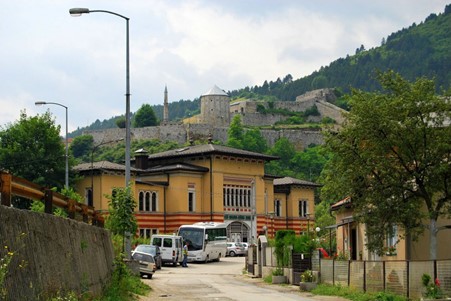
MK: One thing you emphasize, and for good reason, is that for most mujahideen the point wasn’t to create a shari‘a state or the like, but to act in solidarity with Muslims fighting for basic rights without coercing them into any sort of practice. These people came in from other parts of the Muslim world to fight on the side of the local Muslims who were seen, as you’ve said, by Serb and Croat nationalists as settlers, as non-autochthonous, cosmopolitan et cetera. Dis this play any role in the way mujahideen comported themselves or in their propaganda?
DL: Their media output to the outside was not very keyed into these local dynamics. It’s pretty basic, it’s “Muslims are being oppressed by non-Muslims.” It’s also about educating other Muslims about the Muslim presence in Bosnia, saying “hey, there are these European Muslims, they’re not converts, they’ve been Muslims for hundreds of years.” Maybe they’ll allude to the idea that Serbs and Croats call them Turks and settlers, but for those audiences that’s almost already baked in. The assumption of animosity from non-Muslim parties is not something that needs to be proven with a lot of evidence in these materials, so the discourse doesn’t need to address it very explicitly.
MK: It’s such a minefield, maybe they were trying to keep it basic to not get into these quandaries.
DL: Yeah, and they were trying to figure it out themselves.
MK: Moving on from the Ottomans and Austro-Hungarians, I was fascinated by the book’s evocation of circulations within the basins of the Mediterranean and the Indian Ocean. The transnationality of the Hadrami diaspora plays an important role in Abu ‘Abd al-‘Aziz’s biography and in his orientation to jihad, and you make an analogous move with the various Egyptians and North Africans discussed in the book, who seem to be crisscrossing the Mediterranean for significant portions of their lives. How did researching this book help you to think in fresh ways about regions and regionality?
DL: The book tries to move away from the trend in Western academic writing on the Balkans, which is one of epistemic peripheralization vis-à-vis Europe, the idea that it’s the West versus the region; these assumptions have structured most writing over the past few decades. Reimagining regional boundaries and trans-regional connections was a method for understanding this particular phenomenon of jihad, but I think it is helpful for thinking about a lot of other things – for example, capital flows. A lot is coming from the Gulf as well as from other places, like India, with ArcelorMittal owning much of the industry and contributing to environmental problems in Bosnia. So I think finding ways of thinking about connections and flows with other regions is extremely important, because it’s not just Europe that’s there. We’re aware of these things, but when we talk about them as mere capital flows or trade or labor markets we lose something about the sociality of how they’re all tied together.
MK: One thing that this dialogue has brought up for me is the question of the relation between regionality and universalism. It seems that imperial formations and imperial universalisms play a role in the way we think about regions.
DL: Regions and trans-regionalism are extremely important building blocks for the more successful universalist projects and are analytically important for this book, but in the context of this jihad their role and importance are often necessarily denied or suppressed; they don’t have to play a role at the discursive level. The idea that Muslims of all these different nationalities just rose up and went to Bosnia and Afghanistan to fight serves both the liberal security state narrative and that of the participants themselves. The idea is that the commitment is so strong that you’re going to go no matter what.
MK: That’s a really important point about how universalisms tend to disavow their own regionality. I’m thinking about the Soviet bloc: in the West it was thought of as the Eastern bloc, and this brings in connotations of Oriental despotism etc. But the Soviets would have rejected that framing, at least in an official capacity. The Soviet bloc is defined by its ideological commitments and its economic system, not by its culture, much less race or religion. Where these things happen to coincide, it’s supposedly a coincidence, whether fortunate or unfortunate. You can say very similar things about Islam, right? Muslims do happen to be concentrated in particular parts of the world.
DL: Right. Yes. That absolutely makes sense.
… and on the Left
MK: Finally, a question that I imagine you must have faced already. You end the book’s introduction on a provocative political note, arguing that “[f]or all their commitments to […] reactionary politics, those mobilizing in the name of jihad have been among the few actors in recent decades to have taken seriously the challenges of organizing political violence across borders in the face of American empire” (p. 26). There are a lot of ambiguities embedded in this dense sentence. Can the reactionary commitments of “those mobilizing in the name of jihad” really be reduced to a “for all that”? And what does “in the face of” mean, exactly? In the past few decades, the relationship of mujahideen to the US empire seems to have been entirely contingent. So can you expand on what precisely it is that we can learn from the mujahideen about a “grounded and reflexive approach to violence” in the face of empire? I think you’re saying what leftists might be interested in taking from mujahideen are lessons about organization and structure, not ideology. Because, now speaking totally as a leftist, I’d really like to know what we can learn from the mujahideen. That isn’t a rhetorical question!
DL: I think your interpretation is correct. As I’ve said in other contexts, the bumper-sticker version is: sure, there’s all sorts of things you can say about these people and their “problematic” orientations, and you can accept all those arguments and still say, “well, if they’re so problematic but they’re taking on these very difficult challenges that we are not, then what does that say about the left?”
Even having this conversation about jihad is already a significant step forward, not just from liberal and academic discourses, but even for a lot of people on the left that have not really reckoned with these questions. This is where I think we need more empirical research, because a lot of our received notions about the relationship between the left and Islamic movements also need to be rethought. The story is one of antagonism as well as overlap. I know Timothy Nunan is doing some interesting research on this at the moment.
MK: In what geographical context is that?
DL: I’m not exactly sure, but it’s about left and Islamic internationalisms in the ‘60s and ‘70s. We think of 1979 as the year of an Islamic revolution in Iran, following a communist revolution in ‘76 in Afghanistan that gives way to an Islamic resurgence. But this story cuts out the rich tradition of left and Islamic interaction leading up to that point. We can think of the Islamic revolution as Islam plus Iranian nationalism, but we can also think of it as part of a whole series of insurrections on both sides of the Gulf throughout the 1960s and ‘70s. On the west side of the Gulf, you have the revolution in Dhofar, and labor militancy in Bahrain and Kuwait. Nasserism is also very much in evidence. The ‘70s were a hot time in the Gulf, but this has been entirely effaced by the triumph of petro-capital there. And of course, communists played a significant role in the 1979 revolution in Iran.
The history of Soviet rule in Central Asia also has to be revisited, because there are stereotypes on both ends, about regressive gender politics as well as about coercive violence, things like forcible de-veiling. All these things should be revisited and re-explored. Of course there are going to be genuine disagreements and antagonisms, research can help to build out a broader sense of the possibilities, of the range of interaction. Politically as well, because we are in a moment where those tensions are apparent in anti-war and anti-militarist organizing in many spaces, these tensions are there. They might be latent, but it’s something that I think, whether we’re talking about Israel/Palestine, the US, or the UK, we’re at a kind of quasi-Popular Front moment. Finding better ways of approaching these conversations and questions seems worthwhile.
MK: Absolutely! In the US, the figure of Congresswoman Ilhan Omar would be interesting to look at in that respect, because she’s a visible hijabi Muslim and a Black woman as well as a pretty radical leftist on all fronts, and she gets shit for all of it. And it’s interesting to invoke the Popular Front model at a moment that brings these issues together. But that is actually a different kind of answer from what I was expecting. I was expecting something more along the lines of – let’s look at the structure of these organizations rather than their ideologies.
DL: That’s true too, but you anticipated that answer to your question, so I took the next step.

MK: All that is well taken. Empirically, though, in Bosnia the mujahedin are entering a country that has been socialist until recently, and many of them are coming from Afghanistan, where they were fighting against a socialist regime. What was their attitude towards these questions of socialism vs. capitalism, left vs. right?
DL: This is a little difficult to answer, because my interviews take place many years after the fact. Anti-communism is just not a strong theme in my interviews because at that point it was mainly irrelevant, and even in the contemporary discourse communism is mentioned primarily as one of the reasons why Bosnians have not been allowed to practice their faith correctly. But the Cold War is over! So they’re updating their discourses. Also, a lot of the folks I spoke to are very comfortable with broadly social-democratic politics, welfare states and the like. Islamist political projects are not at all incompatible with social welfare orientations; the Islamic Republic of Iran is the biggest example of that.
If I had spoken to more Gulfies, I might have gotten more anti-communism, but even in the Gulf anti-communism is related to specific political antagonisms. For example, in the Hadrami diaspora that I write about, many feel aggrieved by the People’s Democratic Republic of Yemen, due to concrete antagonisms around their property getting nationalized. And again, geopolitics is interesting here: in the 1980s the Saudis are supporting jihad against the Soviets in Afghanistan, but also low-key supporting the socialist PDRY to undermine North Yemen. Fighting communism at their front doorstep is somehow less of a priority than in Afghanistan.
MK: This is starting to sound a lot like Southeast Asia in the 1980s, where Thailand, China and the US are supporting the Khmer Rouge against Vietnam and the USSR…
DL: Exactly, and I think that complexity matters. Not in the endless way that some anthropologists use the term, as a way to dodge having commitments, but as a way of recognizing that there are multiple axes of antagonism that cross-cut each other. And southeast Europe is definitely one place where this comes out, because historically it has not been securely in the camp of any major power: it has been a site of contestation. That’s why left discussions about Palestine and Central America look very different from left conversations about Syria and ex-Yugoslavia.
MK: I think I understand your statement now as an even stronger one. You’re actually talking about needing to approach the question of commonalities between the left and political Islam with fresh eyes.
DL: Yes. The book is really written for folks who are trying to dwell in that space of connection between the left and Islam.
MK: Well, I’m definitely in the target audience! And I believe a few others will also find it interesting. Thank you so much for your time.

Darryl Li is Assistant Professor at the University of Chicago. He is an anthropologist and attorney working at the intersection of war, law, migration, empire, and race with a focus on transregional linkages between the Middle East, South Asia, and the Balkans.

Matan Kaminer is a political activist and anthropologist. He writes about Thai migrant workers in Israel, and is currently a postdoctoral fellow at the Buber Society of Fellows, Hebrew University of Jerusalem. Matan is a member of the board at Academia for Equality, an organization for the democratization of Israeli academia and society, and at LeftEast.

